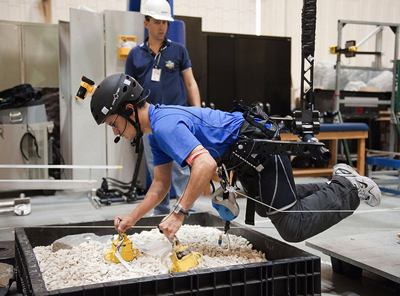By Jennifer Clampet
UTEP News Service
Jose Hurtado, Ph.D., has a grounded career – meaning that geology tends to keep him close to the Earth.
“It’s about how to teach people to operate in a scientific manner, to be a scientist and a geologist in addition to being an astronaut,” said Hurtado, an associate professor of geological sciences at The University of Texas at El Paso.
Since 2009, Hurtado’s Earth-bound expertise has been used to help train astronauts in the field of geology, to test new exploration technology and to explore independent research on exploiting resources from the moon. The latter is done in cooperation with UTEP’s Center for Space Exploration Technology Research – a project funded through NASA and overseen by the College of Engineering.
Hurtado’s latest adventure at the Johnson Space Center in Houston teamed him up with astronaut Alvin Drew for a week-long RATS (research and technology studies) testing in January.
The duo survived three days together in a cramped Multi-Mission Space Exploration Vehicle (MMSEV) — a prototype of the vehicle NASA would use for future exploration of near-Earth asteroids.
“The goal (of NASA) is to visit an asteroid by 2025,” Hurtado said. “We test out the technology and procedures that hopefully will help us achieve that. So we try it here first on Earth and hopefully we do it in space some day.”
But the real question for NASA as it pursues missions of exploring near-Earth asteroids is: “How does one do geology on an asteroid?”
Imagine the setting in space for a continually rotating rock about 1 kilometer in diameter.
It spins on multiple axes. And the big hunk of rock lacks any substantial gravitational pull. Its microgravity is dangerous ground for testing Newton’s law of equal and opposite reactions – where a simple flick of a geologist’s trusted hammer can shoot an astronaut into a dark abyss.
Hurtado tried his hand at this simulated microgravity challenge using ARGOS – NASA’s space walk simulator winch system. Hanging from a cable, Hurtado found himself suspended over pits of simulated asteroid materials.
“Microgravity is definitely one of the biggest challenges in space for a geologist,” Hurtado said.
The sensitive rigging equipment intended to duplicate a low gravity surface gave the professor heart-pounding reminders of how dangerous it was just to push off of a boulder while climbing along in the simulation. One thrust upward and Hurtado could have taken off to the ceiling of the hangar.
Geology plays a crucial part in NASA missions developed for landing on surfaces such as the moon, Mars or asteroids. The collection of rocks and minerals was a scripted task during the Apollo missions. Today, NASA is looking at the importance of astronauts calling the shots on the scene.
“We should trust what astronauts are seeing firsthand,” Hurtado said.
As an instructor, Hurtado has trained astronauts in desert settings to practice techniques used in the field of geology.
From the San Francisco Volcanic Field in Arizona to the Kilbourne Hole in New Mexico, astronauts were instructed how to use observations to make assumptions on geological history. That is important when it comes to deciding which samples are the most crucial to bring back from a mission.
Hurtado’s colleagues in geology have embraced his training of astronauts. Hurtado has used Skype to teach classes from the field and even brought students along for some of the events.
“We’re happy to have Hurtado in our department,” said Laura Serpa, UTEP chair of the Department of Geological Sciences. “He’s doing amazing things in research with NASA and he’s bringing that to the classroom. He’s getting his students involved. I even use his participation with NASA when I’m out recruiting students for the college.”
Hurtado, who received his Ph.D. in geology from the Massachusetts Institute of Technology and earned graduate and undergraduate degrees from the California Institute of Technology, always has had his eyes on space.
In 2009 he made the top 100 candidates under consideration for the NASA astronaut training program. Since then, Hurtado excitedly recounts his tales as a “pretend astronaut” on training missions for the exploration programs.
In fact, he has recently applied again to be considered for astronaut candidacy.
“It’s the idea of space exploration. I’d like to be part of that somehow,” Hurtado said. “And if I was chosen as an astronaut, I think it would be good for UTEP.”
